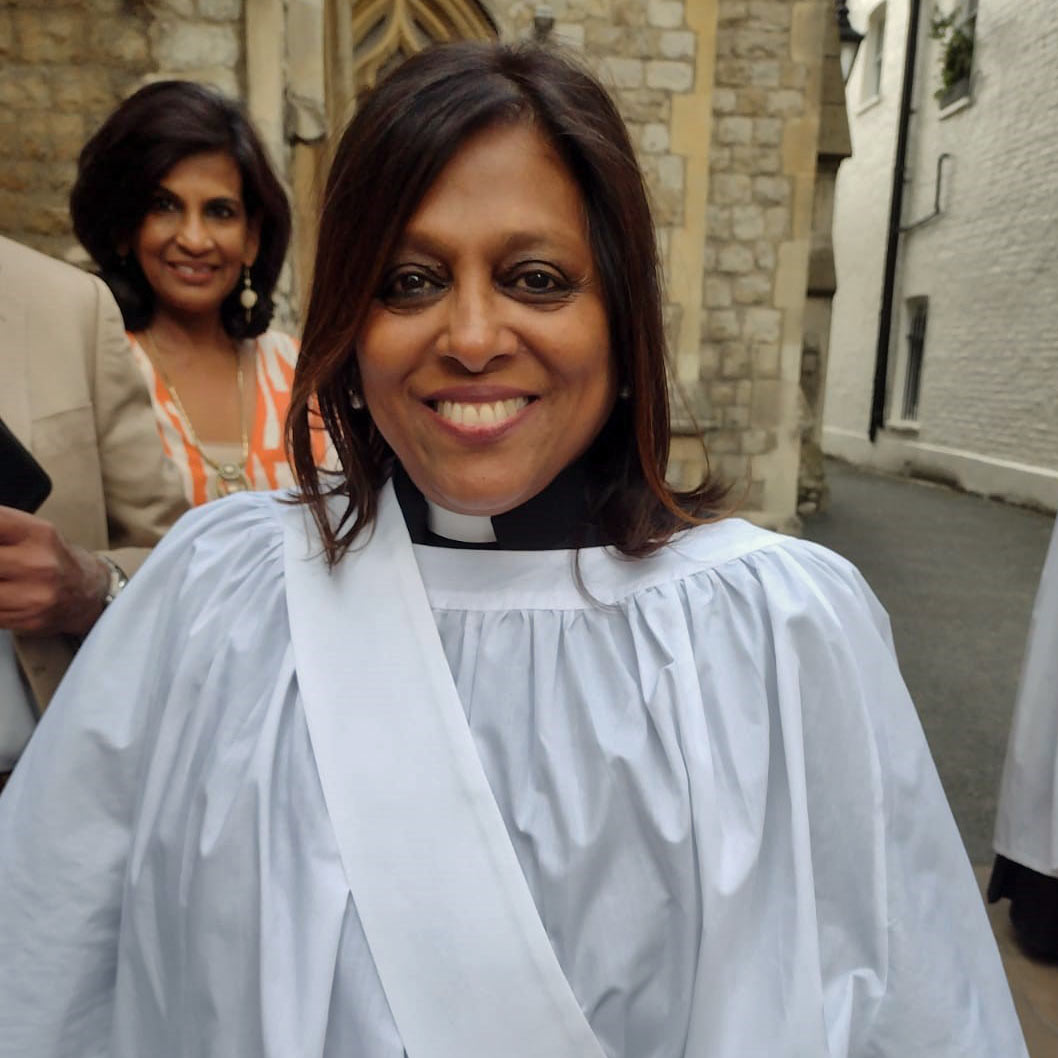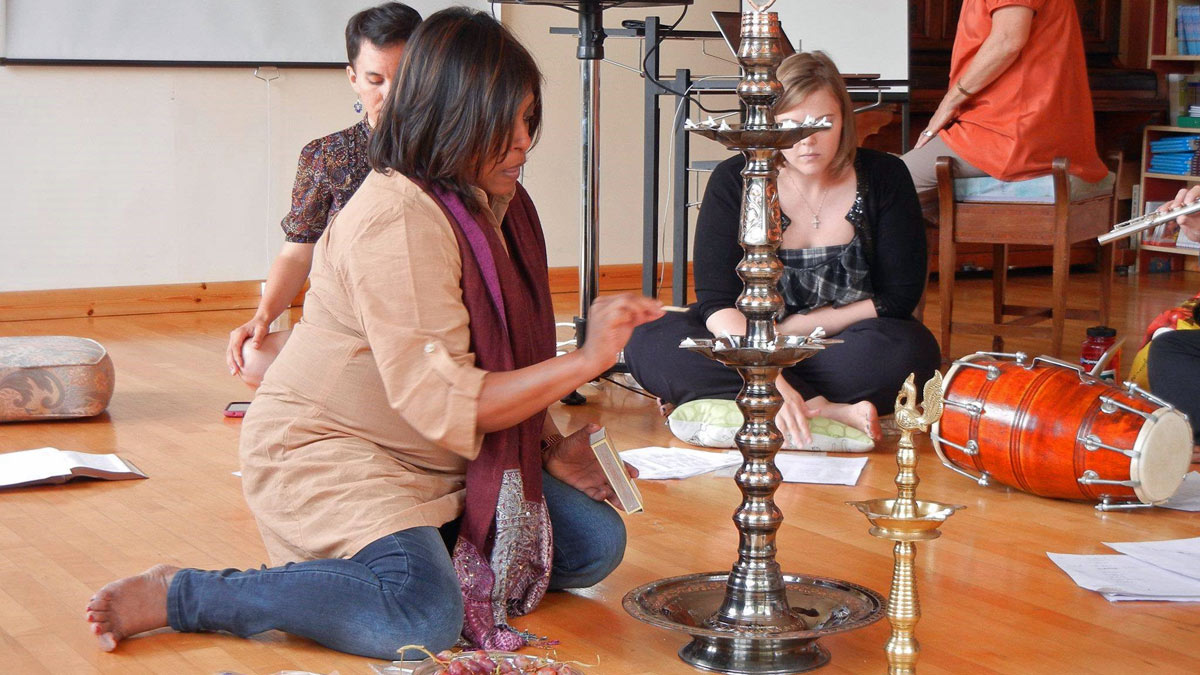Rev Ruwani Gunawardene, a second year MA student with CMS Pioneer Mission Training, narrates a personal journey into the Asian Satsang style expression of worship
I am a second year Curate in the Church of England serving my title at St James the Less church in Pimlico, Westminster. St James is a beautiful Victorian building serving the two local estate communities in one of the poorest parts of the richest borough in London with the Houses of Parliament and the iconic Big Ben only a few minutes’ walk down the road.
Wherever you are reading this in the world, are you now ready to take a trip down to a historic tropical island in the Indian ocean, where my story began…?
Ayubowan!
My formative years were spent in the island of Sri Lanka which was then called Ceylon. My family worshipped in the original Anglican Cathedral community in the capital Colombo, where they still worship, now for nearly 70 years. It is no longer the cathedral as the bishop’s throne was moved to a more modern building some 50 years ago. The architecture of the new cathedral is significantly different from the original cathedral, bearing indigenous characteristics and looking less like a church from the Home Counties in England.
My parents belonged to the first young adult generation of the post-colonial era. We spoke Sinhala and English at home. Church was mainly Sung Eucharist accompanied by the English Hymnal and pipe organ, with the occasional chorus sung at Sunday School. Even musical training I received as a young girl was Western classical. However, school and learning Divinity as a subject was in Sinhala. From a very young age we were bi-lingual, easily dipping in and out of both languages and colloquially mixing the two and forming a hybrid which we call ‘Singlish’!
But church was in English…
We kept our Christian identity neatly tucked away, culturally inhabiting Western practices, safe from the predominant Sinhala Buddhist culture which was all around us. If one was Sinhalese one was expected to be a Buddhist. To be something else was to be second class. Although there was general respect for each other’s religions, we were very much felt to be a minority.
Church was also a place that all culture groups of the island, namely, Sinhalese, Tamil and Burgher communities congregated in one space. There are minority Muslim and Malay communities, descendants of the ancient travellers from the far East and beyond on the Silk Route. Sri Lanka was and is a melting pot of mini culture groups which have lived side by side for nearly 3,000 years.
Post-colonial pressures
Sri Lanka (Ceylon) was under European rule for nearly 350 years. Colonised by the Portuguese, Dutch and finally the British spanning over four centuries, Sinhalese culture was suppressed for most of this time. With the colonial practice of ‘divide and rule’ the minority Tamil citizens were educated and given prominent positions in government by the European invaders.
It was not surprising therefore, that soon after Independence in 1948 the majority Sinhala speaking leaders made Sinhala the official language of the country, thus alienating the other communities in the island. Civil tensions that began as a result culminated in a full-blown civil war in 1983 and thus started one of the longest running civil wars in Asia of modern times – of nearly 30 years.
It was during this time there was an exodus of my generation, and I settled in London after an arranged marriage to a Sinhalese Buddhist. Mixed faith marriages were commonplace in Sinhala Christian families.
Looking back, I could easily say that joining my local church and experiencing the love and acceptance of this small Baptist community helped me to integrate into the new culture I was in and grow deeper in my faith.
Our eldest son was born 10 years later, and we moved out of London to settle in the countryside in England to raise our family. Sadly, we did not feel very welcome in our new surroundings, and we moved back to the safety of multi-cultural London. Our second son was born a month after the move.
Plucking the heart strings
Church in the suburbs of London turned to be a refuge at first with a buzzing Sri Lankan Fellowship. The local Anglican church had a significant group of Tamil refugee worshippers who met separately to worship in their language. At first this was a welcome retreat from our experience in the countryside. Not long after I had a deep dissatisfaction that this was unhelpful. I remembered the welcome I received from my first church and being part of the bigger church community. But here we were segregated, and the main church was felt to be the real church. I felt my community was missing out on the richness of God’s kingdom, being separated in our own culture group.
I felt we were basically feeding into racism and by gathering in our culture group, perpetuating our own Sri Lankan culture on the one hand, and losing out on the vast richness of worshipping with the local people on the other.
 Pioneering across cultures: Rev Ruwani Gunawardene
Pioneering across cultures: Rev Ruwani GunawardeneContemporary worship was really picking up pace around this time in Britain in the early 2000s. I grew up singing traditional Anglican hymns and now enjoyed the contemporary British worship scene. Graham Kendrick, Matt Redman, Tim Hughes…love them! All through this time, questions were rising within me as to how I could reconcile my culture with the worship culture in Britain. And the sounds that I had heard growing up, classical Asian sounds of sitar, violin, tabla and Sri Lankan drumming still pulled at my heart strings. I started to begin to feel that a part of me was missing and was crying out to be released.
I realised that even after decades of living among Western people, a deep part of me remained Sri Lankan. Something was stirring and it was not only within me – God was moving and shifting things all over, it seemed.
Worlds colliding
When God is doing something in his Kingdom, he brings people together you were most unlikely to meet in the normal discourse of life. Through my work at LST I came across Chris Hale and Pete Hicks’ group Aradhna. Two young white men personifying Desi culture! The sounds that Aradhna played were just exquisite. Chris and Pete had made a conscious effort to embrace the culture they were growing up in, in India and Nepal, and mastered the Hindi worship traditions of Bharat Mata or Mother India. This was a familiar sound, but not one I had EVER associated with Christianity. Wow! How our worlds collided.
With other like-minded folk, we formed the Imagine Multi Cultural Worship Forum and started learning Satsang songs which are called bhajans and played at Greenbelt festival and other venues. I made the video above after one such event.
Communal freedom
I love the communal nature of a Satsang style worship set. How any empty space could be used and decorated with colourful fabric and scattered flowers and incense. How all worshippers are at a level playing field in the presence of God, seated on the floor (no chairs or pews needed). There is a guru (a spiritual leader) in position but also a deep connection to one another when we take off our shoes and ‘feel’ the ground with our feet.
The music which is led communally will not be too tightly scripted; the Raga style singing can have micro-tones which may be unfamiliar to the Western ear. The ‘call and response’ style singing is easy for anyone to follow. Timing can be fluid… the sound of the manjira gently keeping rhythm as well as the tabla with its unique resonant bass tones. It is a gathering that is very understated and can also be part of a eucharistic service. It is also a multi-sensory experience.
How does a Christian dress?
Another reason I felt compelled to go deeper into exploring Satsang style worship came out of an encounter I had with my older son. I captured it in a poem which first heeds to my early days:
I drew that old suitcase out
With sarees left untouched
Pressed so flat that I could hear
Their cry to escape the rot!
The boys all dressed up tonight
Not a hoody in sight
The red and green saree it is
For mummy this Christmas night.
They were usually cheeky with their comments about my clothes. But what came forth that night by my then twelve-year-old, stopped me in my tracks…..
“Mummy it is not Diwali,
It is Christmas you know
Please change to a dress
So that we can go…”
It must be said at this point that we live in the borough that has the two largest Hindu temples in London and this was an innocent observation from a boy who was in a majority white school and church.
We talked much driving to church and afterwards whilst opening presents – the relationship between faith and dress.
But where does faith and culture meet and what part does geography play in it?
The story does not end here…
living bi-culturally evolves with time…
Until we learn to drape ourselves
in cloaks of yours and mine…
Empowering expression
One might ask why Christians in South Asia are not fully pursuing their cultural expressions of worship?
Mike Balonek, a US ethnomusicologist researched on Sinhala worship and found tensions or fear of change especially in the city churches, although in rural areas people created their own songs. While there is genuine fear of syncretism, I believe that as Christianity has not yet indigenised fully in the island, there is a huge proportion of nominalism which does not help develop praxis.
Peter Phan, a leading Asian ecclesiologist, suggests (and I agree with him) that “what looms large in an Asian theological mindset, is the question having to do with the church’s relation to the outside world rather than the church’s inner life”. Survival in a sea of other world religions and socio-political challenges mean the church is constantly on alert for issues raised from the outside. There is little time to delve into intellectual debate or cultivate new praxis. So, the worship practices adopted at the onset to avoid syncretism continue.
I sense the journey I have been on can help redress this imbalance to an extent. Highlighting the need to release our South Asian Christian family to embrace their art forms in worship can empower them to do so, if brothers and sisters in the West work together with us. It gives value, recognition, collaboration and helps to have a critical eye on things and can also be an effective missional tool in the West.
Taste and see
For an artform to last, it needs an audience and people who appreciate it. And I believe one of the reasons that Western worship has had a long shelf life is because there was a multi-national audience for it – a sort of a captive audience at some point(!) but an audience, nevertheless. So just as much as we loved the sounds of the Global North, I think it is right that we now invite our brothers and sisters to taste and see the sounds of the Global South.
London’s largest migrant community are South Asians from all world faiths. We have an Indian Hindu Prime Minister in the UK now. What would it be like to organise a Satsang at a Parliamentary Prayer Breakfast one day?
This is an edited version of a talk given at GCAMM 2023 (Global Consultation on Arts and Music in Missions). Ruwani blogs at interculturalru.com

